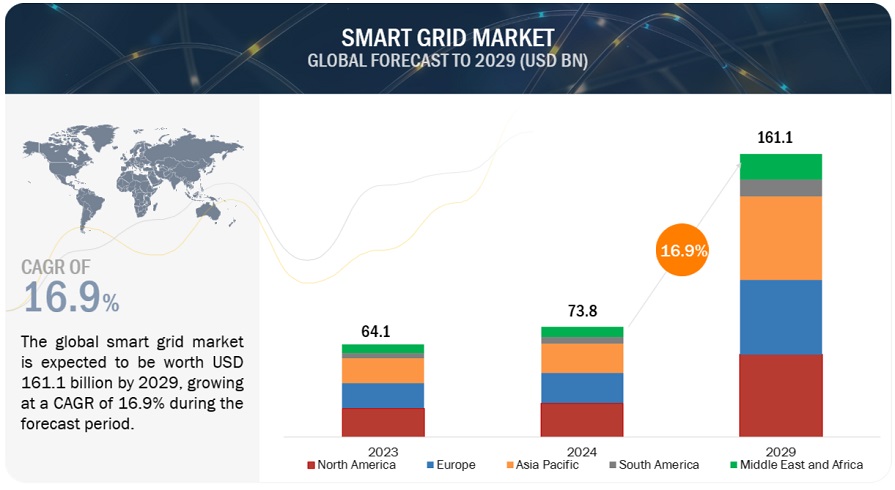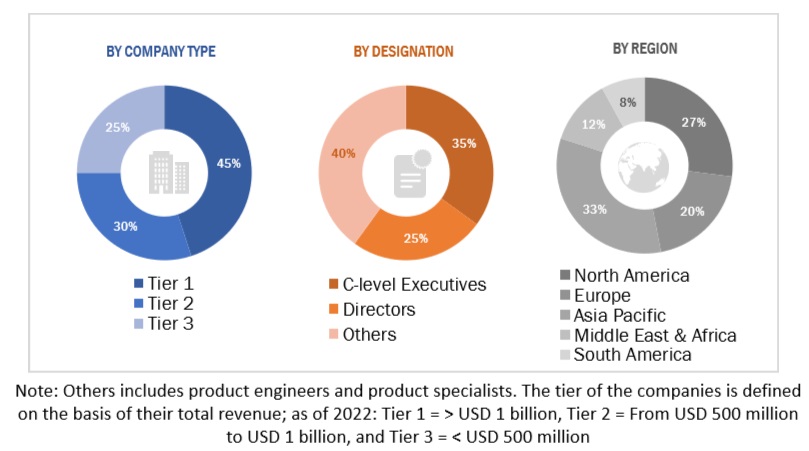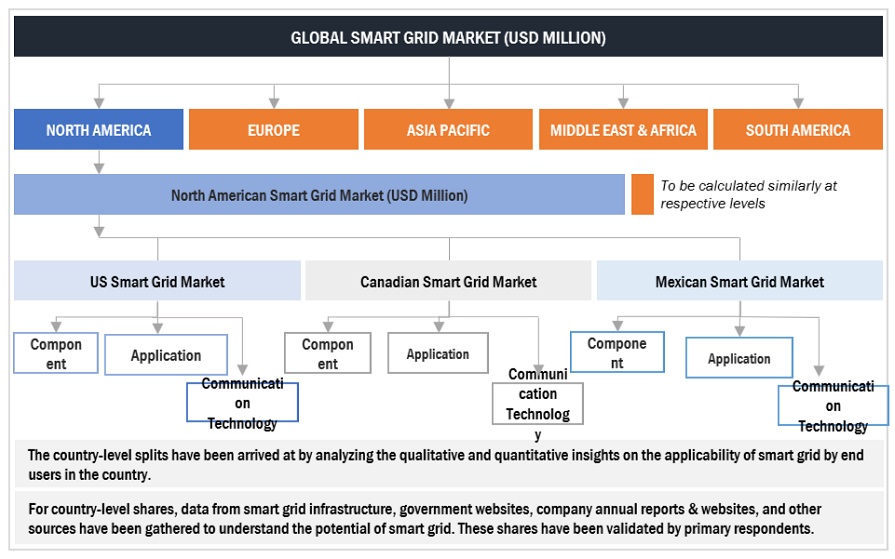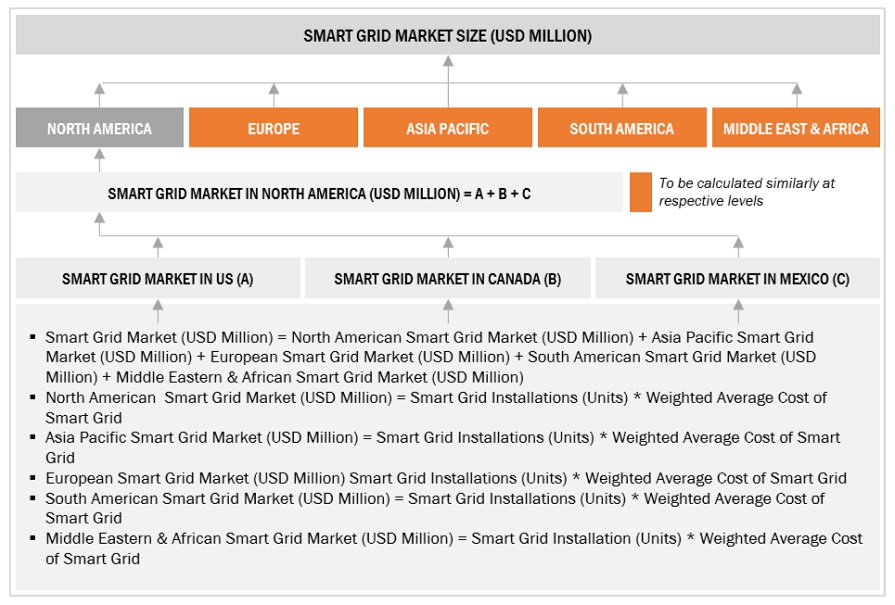Smart Grid Market by Component (Software, Hardware (Smart Meters, Sensors, PLC), Services), Application (Generation, Transmission, Distribution, Consumption), Communication Technology (Wireline, Wireless), & Region - Global Forecast to 2029
[350 Pages Report] The smart grid market is expected to grow from an estimated USD 161.1 billion by 2029 from an estimated USD 73.8 billion in 2024, at a CAGR of 16.9% during the forecast period. The demand for smart grid is growing due to the supportive regulatory framework of governments worldwide to promote deployment of smart grids and spreading awareness about energy conservation. Additionally, With the increasing complexity of the bulk power system and the growing focus on mitigating power outages, smart grid technology is poised to transform the traditional grid and is likely to become a more reliable and resilient approach.

To know about the assumptions considered for the study, Request for Free Sample Report

To know about the assumptions considered for the study, download the pdf brochure
Smart Grid market Dynamics
Driver: Improved grid reliability and efficient outage response
As the world shifts towards sustainable development, renewable energy sources like wind, solar, biofuels, hydro, and geothermal now contribute over 15% of global energy generation. With the increasing complexity of the power system and a focus on reducing outages, smart grid technology is set to revolutionize the traditional grid, enhancing reliability and resilience. This technology enables utilities to expedite power restoration after major storms, cutting costs and downtime, thus minimizing financial losses. By providing superior situational awareness and utilizing cloud-processed data for autonomous control, smart grids enhance outage detection and restoration capabilities through automation and big data analytics. To further improve outage prevention, utility providers should incorporate outage mapping and analytical tools to leverage smart grid data fully. While integrating small-scale renewable sources into traditional grids can cause fluctuations and waste, smart grids help optimize electricity consumption and reduce carbon emissions. The smart grid infrastructure facilitates the integration of renewable energy at both transmission and distribution levels, making it more accessible for commercial and residential use.
Restraints: Low awareness of protocols and interoperability standards
Utility providers encounter several challenges in deploying smart grid technology, including issues related to security, standards, and interoperability. A major obstacle is the lack of awareness among smart grid system designers about existing standards, leading to non-compliance during manufacturing. Additionally, integrating interchangeable parts from various global providers poses significant difficulties for manufacturers. Although utility providers can purchase and deploy equipment from multiple vendors, there is a pressing need for interoperability standards to ensure seamless interaction with existing equipment. Many vendors and equipment providers also lack proper certifications, making it challenging for utility providers to access data from legacy systems. The insufficient knowledge of communication standards, IT protocols, and the need for the latest components and devices further impede smart grid deployment. Despite the efforts of the National Institute of Standards and Technology (NIST) in creating the Smart Grid Interoperability Panel (SGIP) and the recent publication of energy management standards by countries like China, Japan, Brazil, and India, there remains a strong need for global adherence to interoperability standards. Without the implementation of appropriate standards, the full benefits of smart grid technology cannot be realized.
Opportunity Ongoing smart city projects in developing countries
Smart cities are advanced urban areas designed to foster sustainable economic growth and high quality of life through excellence in technology, mobility, environmental practices, living standards, and governance. With over 100 smart city projects underway globally, there are significant opportunities for technology companies, utility service providers, and consulting firms. In smart cities, utilities, safety, transportation, and healthcare services are managed more efficiently and intelligently by leveraging resources and advanced technologies such as IoT and smart energy meters. Traditional power grid models fall short in meeting the needs of energy monitoring, real-time data collection, and smart billing required by modern urban settings. Smart cities will heavily rely on robust smart grid platforms to establish centrally planned and controlled infrastructures. Favorable conditions, including developed ICT infrastructure and improved internet access, are expected to drive the widespread adoption of smart grids in these cities. The APAC region is experiencing rapid urbanization, with both developed and developing countries increasingly adopting smart city technologies. Developing countries like China, India, and Brazil are anticipated to build new infrastructure to support smart grid technology, enabling the private and public sectors to develop cost-effective, innovative solutions.
Challenges: Proper storage and management of complex data generated by smart grid infrastructure
The deployment of smart grid technologies has resulted in the generation of vast and highly complex data sets related to consumer information, utility consumption, and transmission logs. This data is often unstructured and requires processing to extract valuable insights. The continuous data generation from various network nodes poses challenges for smart grid solution providers in efficiently storing and managing this information. Unmanaged data can lead to multiple threats and make it difficult to derive meaningful insights. Authorities need to establish high-volume data centers and deploy analytical solutions without increasing costs.
Utility providers face the significant challenge of understanding the social, economic, and environmental value of smart grid data and developing solutions to aggregate and correlate this information. Smart utilities generate immense volumes of data from millions of smart meters, grid sensors, control devices, and networks of other electronic devices. The challenge for utility technology providers lies in generating and gathering useful data insights for intelligent decision-making. Processing large volumes of data for real-time analytics is a key function of smart grid technology. To stay competitive, solution providers must develop advanced data analytical techniques and accurate predictive analysis models. Offering intelligent business solutions to predict equipment failures, natural disasters, their effects, and customer behavior patterns based on historical data and usage patterns is a complex challenge for utility providers.
Siemens and General Electric are major providers of big data solutions that address smart grid data challenges. There is a need for more solutions and increased investment in analytics to manage and transform data into actionable insights.
Smart Grid Market Ecosystem
Notable players in this industry comprise long-standing, financially robust manufacturers of smart grid Market and related components. These companies have a significant track record in the market, offering a wide range of products, employing cutting-edge technologies, and maintaining robust global sales and marketing networks. Prominent companies in this market include General Electric Company (US), ABB (Switzerland), Siemens (Germany), Schneider Electric (France), and Itron (US).

Hardware, is expected to be the second largest market, based on component
Due to the growing use networking hardware to enable communication between different elements of a smart grid. PLC carries out control and monitoring functions in the smart grid. The segment is witnessing significant growth in the market, with the number of players offering cost-effective hardware components. These hardware devices capture numerous data from both consumers and energy utilities to derive useful information and insights. Smart meters are used to capture the data from the end user’s sensors, which are deployed to regulate voltage and current in the system. The expansion of this market is driven by government subsidies, increasing efficency, and environmental consciousness.
Distribution, by application, to hold the largest market share during the forecast period
The distribution segment in the smart grid market is growing rapidly due to the global shift towards reducing energy loss. Distribution intelligence, a part of the smart grid, is applied to the utility distribution system, including wires, switches, and transformers, which connects the utility substation to the customers. As the power industry accelerates electrification efforts, the demand for high-performance and efficient distribution channel is on the rise.
North America is expected to account for the largest market during the forecast period.
North America is the fastest-growing market for smart grid owing to several key factors. The region is witnessing a substantial increase in renewable energy projects, particularly in solar and wind, spurred by government initiatives, tax incentives, and heightened environmental awareness. The United States, in particular, is leading the charge in the adoption of clean energy solutions, creating a strong demand for smart grid technologies to efficiently integrate these renewable sources into the power grid. Advancements in smart grid technology are central to this growth, enabling better energy management, real-time data analytics, and enhanced grid reliability. The electrification of various industries, coupled with the surge in electric vehicle (EV) adoption, further accelerates the deployment of smart grids, as they are essential for supporting the necessary charging infrastructure. As consumers and businesses in North America increasingly prioritize sustainability, the market for smart grid solutions is expanding rapidly. Technological innovations, such as improved data analytics and predictive maintenance, are critical in managing the vast amounts of data generated by smart grids, ensuring efficient energy distribution and minimizing outages. Regulatory support and policies favoring clean energy and technological advancements play pivotal roles in shaping the dynamic and expanding landscape of the smart grid market in North America. This confluence of factors positions the region as a leader in the adoption and implementation of smart grid technologies, paving the way for a more sustainable and efficient energy future.

Key Market Players
The smart grid market is dominated by a few major players that have a wide regional presence.zerland) ABB Group. Leading digital technologies for industry — ABB Group (global.abb), Siemens (Germany) Siemens, Schneider Electric (France) Schneider Electric Glob The major players in the smart grid market are General Electric Company (US) GE Companies: Next Generation and Future | General Electric, ABB (Swital | Global Specialist in Energy Management and Automation (se.com), Wipro (India) Wipro | Digital, Technology, Business Solutions,Oracle (US) Oracle | Cloud Applications and Cloud Platform, Cisco (US) Oracle | Cloud Applications and Cloud Platform, Eaton (Ireland) Global power management company | Eaton, MITSUBISHI HEAVY INDUSTRIES, LTD (Japan) Mitsubishi Heavy Industries, Ltd. Global Website (mhi.com), and Itron (US) Home - Itron.Between 2019 and 2023, Strategies such as product launches, contracts, agreements, partnerships, collaborations, alliances, acquisitions, and expansions are followed by these companies to capture a larger share of the smart grid market.

Want to explore hidden markets that can drive new revenue in Smart Grid Market?
Scope of the Report

Want to explore hidden markets that can drive new revenue in Smart Grid Market?
|
Report Metric |
Details |
|
Market size available for years |
2022–2029 |
|
Base year considered |
2023 |
|
Forecast period |
2024–2029 |
|
Forecast units |
Value (USD) |
|
Segments covered |
Component, application, communication technology and Region |
|
Geographies covered |
Asia Pacific, North America, Europe, Middle East & Africa, and South America |
|
Companies covered |
General Electric Company (US), ABB (Switzerland), Siemens (Germany), Schneider Electric (France), Itron (US), IBM (US), and Wipro (India).Globema (Poland), Trilliant Holdings (US), EsyaSoft Technologies (India), Xylem (US), and eSmart Systems (Norway).Kamstrup (Denmark), Tech Mahindra (India), Oracle (US), Cisco (US), Eaton (Ireland), ENEL X (Italy), and C3 Energy (US).Grid4C (US), NES (US), SAP (Germany), Mitsubishi Electric (Japan), Honeywell (US), and Tantalus (US). |
This research report categorizes the smart grid market by component, application, technology, and region
On the basis of component, the smart grid market has been segmented as follows:
- Software
- Hardware
- Services
On the basis of application, the smart grid market has been segmented as follows:
- Generation
- Transmission
- Distribution
- Consumption/End use
On the basis of Communication Technology, the smart grid market has been segmented as follows:
- Wireline
- Wireless
On the basis of region, the smart grid market has been segmented as follows:
- Asia Pacific
- Europe
- North America
- Middle East & Africa
- South America
Recent Developments
- In July 2021, GE Renewable Energy, in partnership with Ccalpine, has completed the Santa Ana storage project in Southern California. The project will be able to provide energy to up to 12,000 households during peak events, and 24,000 households during normal load conditions.
- In April 2018, ABB launched a digitally integrated power transformer. The digital capabilities of this transformer enhance the reliability and efficient utilization of grid assets and power networks.
- In August 2021, Siemens Limited and Tata Power Delhi Distribution Limited (Tata Power-DDL) successfully deployed Smart Metering Technology for over 200,000 smart meters in North Delhi.
- In November 2021, Schneider Electric acquired DC Systems BV, which is a major supplier of smart systems. This has helped the company in advancing innovations in electrical distribution.
- In January 2021, Versant Power deployed Itron’s AMI solution across its service territory for data management, analytics, grid performance, increased operational efficiency, and a better customer experience. With Itron’s intelligently connected network and high-performance endpoints, the utility is equipped with better outage management capability and the foundation for future customer programs.
Frequently Asked Questions (FAQ):
What is the current size of the smart grid market?
The current market size of global smart grid market is 60.3 billion in 2023.
What is the major drivers for smart grid market?
The global smart grid market is driven by Increasing investments in energy infrastructure development.
Which is the fastest-growing region during the forecasted period in smart grid market?
Asia Pacific is a fastest market the Asia Pacific region emerged as a notably expanding market for smart grid market.
Which is the largest segment, by component during the forecasted period in smart grid market?
Software dominate the smart grid market by component segment due to increasing global adoption of new technology. With rising environmental awareness, government incentives, and decreasing costs, demand for smart grid is expanding rapidly.
Which is the largest segment, by communication technology during the forecasted period in smart grid market?
Wireline communication technology is the largest segment of the smart grid market since they are the most crucial components of power networks. .
To speak to our analyst for a discussion on the above findings, click Speak to Analyst
The study involved major activities in estimating the current size of the Smart Grid market. Exhaustive secondary research was done to collect information on the peer and parent markets. The next step was to validate these findings, assumptions, and sizing with industry experts across the value chain through primary research. Both top-down and bottom-up approaches were employed to estimate the complete market size. Thereafter, market breakdown and data triangulation were used to estimate the market size of the segments and subsegments.
Secondary Research
This research study on the Smart Grid market involved the use of extensive secondary sources, directories, and databases, such as the International Organization for Standardization (ISO), the International Electrotechnical Commission (IEC), the American National Standards Institute (ANSI), the Geography Markup Language (GML) to identify and collect information useful for a technical, market-oriented, and commercial study of the global Smart Grid market. The other secondary sources included annual reports, press releases & investor presentations of companies, white papers, certified publications, articles by recognized authors, manufacturer associations, trade directories, and databases.
Primary Research
The Smart Grid market comprises several stakeholders such as smart grid manufacturers, manufacturers of subcomponents of smart grid, manufacturing technology providers, and technology support providers in the supply chain. The increased use of energy sources worldwide, especially in industrial and commercial projects, is driving up demand for smart grid. Smart grid technology attracts customers from the public and private sectors owing to its several benefits providing numerous opportunities for building smart infrastructure. Utility providers, solution providers, electronic device manufacturers, and system integrators are developing cost-effective and reliable solutions in the emerging smart grid market.

To know about the assumptions considered for the study, download the pdf brochure
Market Size Estimation
Both top-down and bottom-up approaches were used to estimate and validate the total size of the smart grid market. These methods were also used extensively to estimate the size of various subsegments in the market. The research methodology used to estimate the market size includes the following:
- The key players in the industry and market have been identified through extensive secondary research, and their market share in the respective regions have been determined through both primary and secondary research.
- The industry’s value chain and market size, in terms of value, have been determined through primary and secondary research processes.
- All percentage shares, splits, and breakdowns have been determined using secondary sources and verified through primary sources.
Global Smart Grid Market Size: Top-down Approach

To know about the assumptions considered for the study, Request for Free Sample Report
Global Smart Grid Market Size: Bottom-Up Approach

Data Triangulation
After arriving at the overall market size from the estimation process explained above, the total market has been split into several segments and subsegments. To complete the overall market engineering process and arrive at the exact statistics for all the segments and subsegments, the data triangulation and market breakdown processes have been employed, wherever applicable. The data has been triangulated by studying various factors and trends from both the demand- and supply sides. Along with this, the market has been validated using both the top-down and bottom-up approaches.
Market Definition
A smart grid is an electricity network enhanced with digital technology to enable advanced monitoring, automation, control, and management of energy transmission, distribution, power generation, and network supply. This technology facilitates the evolution from traditional energy distribution to an intelligent electricity grid, allowing two-way communication between utility providers and their customers. Smart grid systems employ digital communication technologies, information systems, and automation to monitor energy flow and adjust to changes in energy demand and supply. By integrating smart metering systems, it enables real-time monitoring of power consumption, offering both consumers and suppliers real-time data on energy use. Consequently, the smart grid enhances system efficiency and reduces operational costs.
Key Stakeholders
- Energy utilities
- Power service providers
- Solution vendors
- Original equipment manufacturers (OEMs)
- Government agencies
- Managed service providers (MSPs)
- System integrators
- Consultancy firms/advisory firms
- Investors and venture capitalists
- Independent software vendors
- Value-added resellers (VARs) and distributors
- Governments and urban planning agencies
Objectives of the Study
- To define, describe, segment, and forecast the smart grid market, in terms of component, application, communication technology, and region.
- To forecast the market size for five key regions: North America, South America, Europe, Asia Pacific, and Middle East & Africa, along with their key countries
- To provide detailed information about the key drivers, restraints, opportunities, and challenges influencing the growth of the market
- To strategically analyze the subsegments with respect to individual growth trends, prospects, and contributions of each segment to the overall market size
- To analyze market opportunities for stakeholders and the competitive landscape of the market
- To strategically profile the key players and comprehensively analyze their market shares and core competencies
- To analyze competitive developments, such as deals and agreements in the market
Available Customizations:
With the given market data, MarketsandMarkets offers customizations as per the client’s specific needs. The following customization options are available for this report:
Geographic Analysis
- Further breakdown of region or country-specific analysis
Company Information
- Detailed analyses and profiling of additional market players (up to 5)




 Generating Response ...
Generating Response ...









Growth opportunities and latent adjacency in Smart Grid Market
Which market segment is expected to shape the future of the Smart Grid Market?
Smart Grid Market report includes Market Estimates, CAGRs and Forecasts, Rising demand in the Emerging Markets, Opportunity analysis in market for key stakeholders by identification of high growth segments, Trend analysis and study of drivers and restraints that will affect the global landscaps, Key playing fields and burning issues in sector, Market share, contracts & developments, strategies, product innovations of key companies/players and Competition mapping
Smart Grid Market was published in Oct 2021, and it covers the market trends and growth factors with respect to Smart Grid Market. It also covered the Market estimations of Smart Grid in terms of Value by Component/Application/ Communication Technology at regional and country level for the period 2019-2026. The report also covers the detail competitive landscape with key players Market Share Analysis, Developments of Key Market Players Like There Contracts & Agreements, Investments & Expansions, Joint Venture, Partnerships, And Collaborations and their Business Overview, Products/solutions/services Offered, Recent Developments, SWOT Analysis.